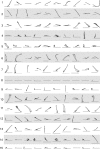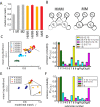Dynamic structure of locomotor behavior in walking fruit flies
- PMID: 28742018
- PMCID: PMC5526672
- DOI: 10.7554/eLife.26410
Dynamic structure of locomotor behavior in walking fruit flies
Abstract
The function of the brain is unlikely to be understood without an accurate description of its output, yet the nature of movement elements and their organization remains an open problem. Here, movement elements are identified from dynamics of walking in flies, using unbiased criteria. On one time scale, dynamics of walking are consistent over hundreds of milliseconds, allowing elementary features to be defined. Over longer periods, walking is well described by a stochastic process composed of these elementary features, and a generative model of this process reproduces individual behavior sequences accurately over seconds or longer. Within elementary features, velocities diverge, suggesting that dynamical stability of movement elements is a weak behavioral constraint. Rather, long-term instability can be limited by the finite memory between these elementary features. This structure suggests how complex dynamics may arise in biological systems from elements whose combination need not be tuned for dynamic stability.
Keywords: D. melanogaster; behavior units; computational biology; locomotion; neuroscience; statistical segmentation; systems biology.
Conflict of interest statement
The authors declare that no competing interests exist.
Figures













Similar articles
-
Inhibitory control explains locomotor statistics in walking Drosophila.Proc Natl Acad Sci U S A. 2025 Apr 22;122(16):e2407626122. doi: 10.1073/pnas.2407626122. Epub 2025 Apr 17. Proc Natl Acad Sci U S A. 2025. PMID: 40244663 Free PMC article.
-
Object preference by walking fruit flies, Drosophila melanogaster, is mediated by vision and graviperception.J Exp Biol. 2010 Jul 15;213(Pt 14):2494-506. doi: 10.1242/jeb.041749. J Exp Biol. 2010. PMID: 20581279 Free PMC article.
-
Statistical structure of locomotion and its modulation by odors.Elife. 2019 Jan 8;8:e41235. doi: 10.7554/eLife.41235. Elife. 2019. PMID: 30620334 Free PMC article.
-
Functional senescence in Drosophila melanogaster.Ageing Res Rev. 2005 Aug;4(3):372-97. doi: 10.1016/j.arr.2005.04.001. Ageing Res Rev. 2005. PMID: 16024299 Review.
-
The importance of being active.J Neurogenet. 2009;23(1-2):120-6. doi: 10.1080/01677060802471643. Epub 2008 Dec 20. J Neurogenet. 2009. PMID: 19107633 Review.
Cited by
-
Fine-grained descending control of steering in walking Drosophila.bioRxiv [Preprint]. 2023 Oct 30:2023.10.15.562426. doi: 10.1101/2023.10.15.562426. bioRxiv. 2023. Update in: Cell. 2024 Oct 31;187(22):6290-6308.e27. doi: 10.1016/j.cell.2024.08.033. PMID: 37904997 Free PMC article. Updated. Preprint.
-
OptiFlex: Multi-Frame Animal Pose Estimation Combining Deep Learning With Optical Flow.Front Cell Neurosci. 2021 May 28;15:621252. doi: 10.3389/fncel.2021.621252. eCollection 2021. Front Cell Neurosci. 2021. PMID: 34122011 Free PMC article.
-
An ensemble approach to the structure-function problem in microbial communities.iScience. 2022 Jan 11;25(2):103761. doi: 10.1016/j.isci.2022.103761. eCollection 2022 Feb 18. iScience. 2022. PMID: 35141504 Free PMC article. Review.
-
Computational Neuroethology: A Call to Action.Neuron. 2019 Oct 9;104(1):11-24. doi: 10.1016/j.neuron.2019.09.038. Neuron. 2019. PMID: 31600508 Free PMC article. Review.
-
The manifold structure of limb coordination in walking Drosophila.Elife. 2019 Jun 28;8:e46409. doi: 10.7554/eLife.46409. Elife. 2019. PMID: 31250807 Free PMC article.
References
-
- Baerends GP. The ethological analysis of fish behavior. Fish Physiology. 1971;6:279–370. doi: 10.1016/S1546-5098(08)60150-8. - DOI
-
- Barlow GW. Ethological units of behavior. In: Ingle D, editor. The Central Nervous System and Fish Behavior. Chicago: Chicago University Press; 1968. pp. 217–232.
Publication types
MeSH terms
Grants and funding
LinkOut - more resources
Full Text Sources
Other Literature Sources
Molecular Biology Databases

